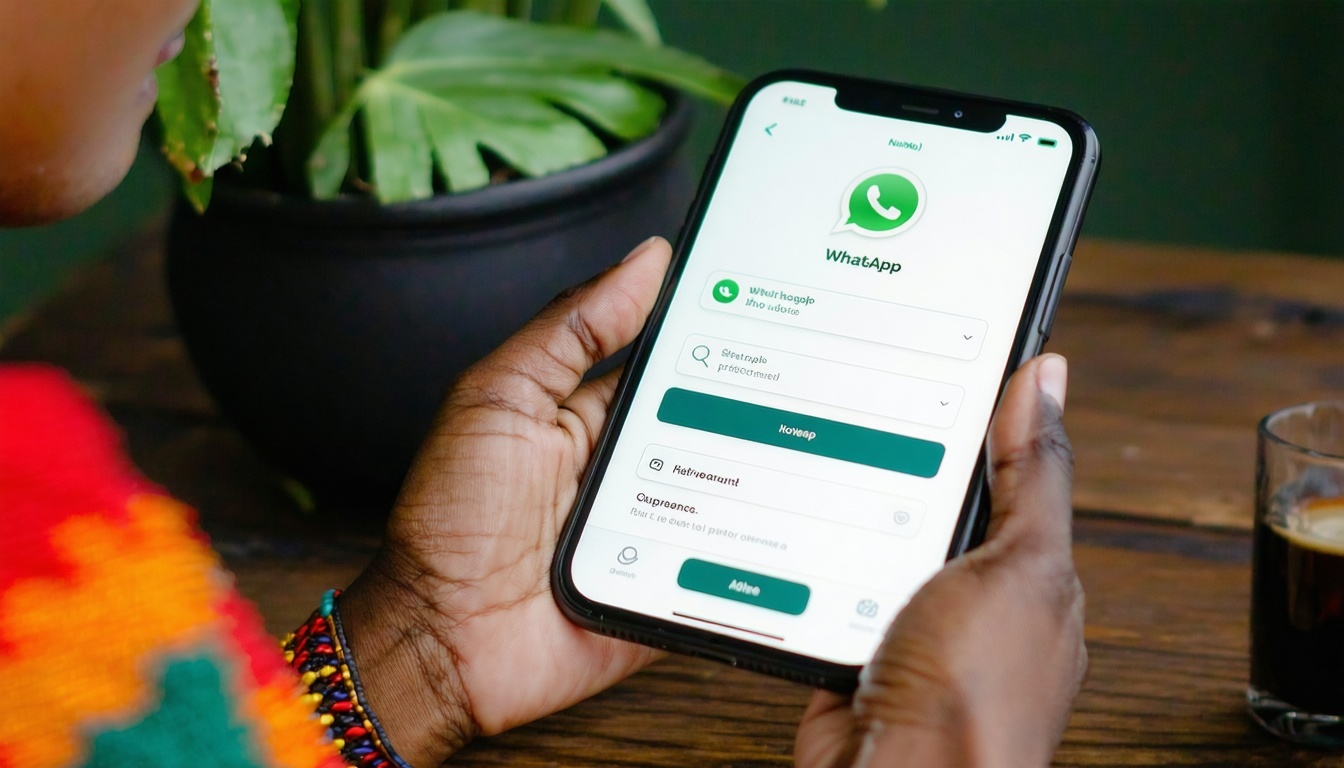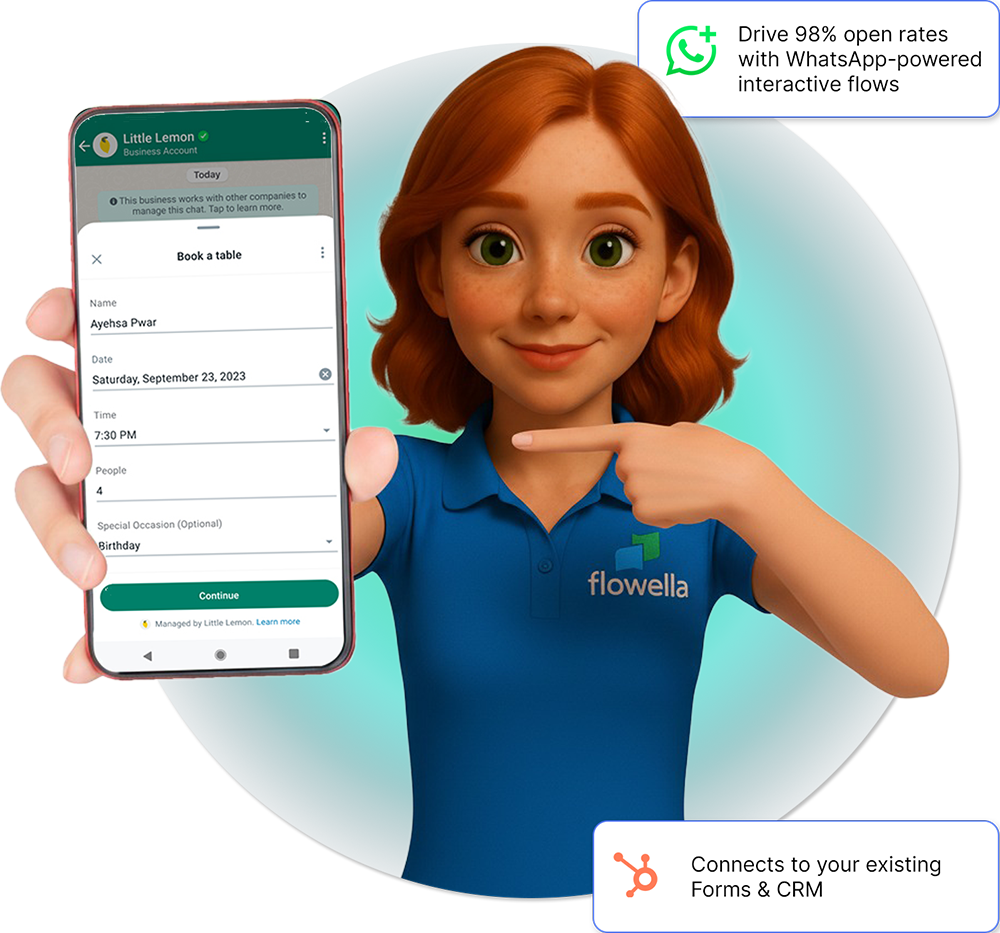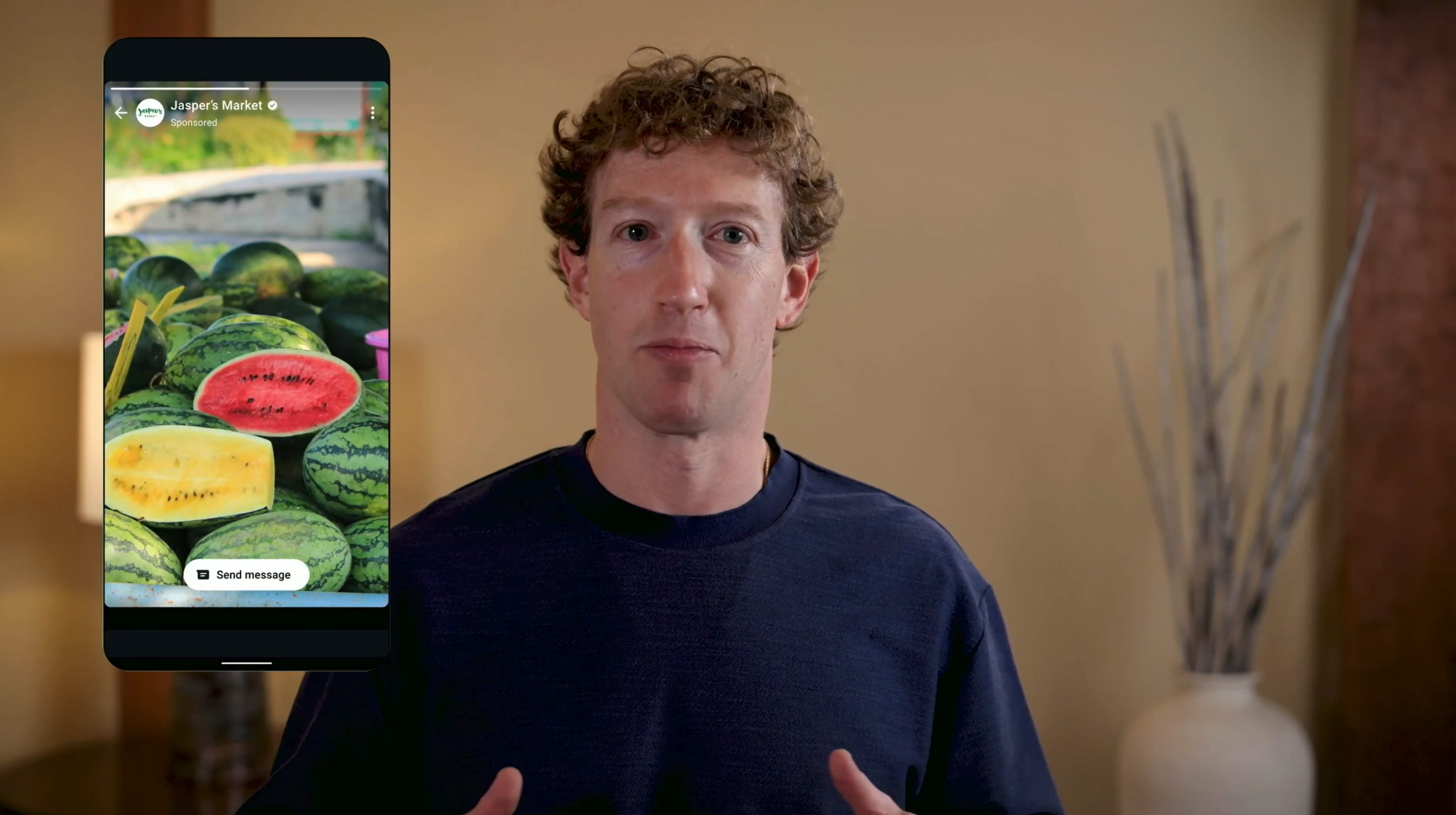
From Chat to CRM: How to Turn WhatsApp Flows into Real Form Submissions—Without Writing Endpoints

TL;DR
WhatsApp is where your customers already are. With WhatsApp Flows, you can collect rich, multi‑step inputs inside the chat. But shipping production‑grade Flows the native way means dealing with encryption keys, custom endpoints, and data‑exchange payloads—a barrier for most marketing teams. This post explains the opportunity, the technical wall, and how Flowella converts the forms you already have (HubSpot, Google Forms, Typeform, SurveyMonkey) into WhatsApp Flows that submit straight back—no custom backend required.
1) The opportunity: meet users where they already respond
WhatsApp has crossed a rare threshold: more than 3 billion monthly active users worldwide, per Meta’s Q1 2025 earnings call. That makes it one of the largest addressable channels on earth—and a natural home for tasks we still force into mobile web forms. (Q4cdn)
What matters for marketers isn’t just reach; it’s response. People reply faster in chat, and conversations feel native on a small screen. If your “update details,” “book a slot,” or “finish onboarding” journeys live behind a slow mobile web form, you’re leaving completions on the table.
2) What are WhatsApp Flows?
WhatsApp Flows are multi‑screen, in‑chat workflows that allow customers to complete structured tasks—think booking an appointment, filling a survey, choosing items—without leaving WhatsApp. Meta announced Flows at its Conversations event in 2023 as a way to make business interactions faster and more complete inside the chat. (About Facebook)
At a high level, a Flow is a small, schema‑driven app: screens, fields, validation, and branching. You can run static screens or dynamic ones that call your backend to fetch options and decide the next screen—great for stock‑aware pickers, personalised offers, or conditional questions. (Providers and community docs call this data_exchange.) (Console Documentation)
3) The technical wall: why teams stall at “pilot”
If you try to ship Flows the native/dev way, you quickly hit three realities:
-
You need to manage encryption and keys
For flows that exchange sensitive data with your endpoint, Meta requires you to set an encryption public key for the business number and handle encrypted payloads from Flows. This isn’t a checkbox; it’s a prerequisite to process dynamic, server‑assisted screens securely. (Postman) -
You need a robust endpoint
Dynamic Flows call a data‑exchange endpoint during navigation. That endpoint must be secure, low‑latency, highly available, and able to return the next screen + input data on demand. (Most providers document variants of this, and teams often run into practical issues when testing.) (Console Documentation, Stack Overflow) -
You need keys and health checks per WABA/number
Implementations by official partners note that each WhatsApp Business Account typically needs a key pair, and numbers sending Flows require proper signing and health status to send reliably. In practice, you end up owning a small platform: keys, endpoints, monitoring, retries. (360Dialog)
Even before you map the data back to your CRM, you’re maintaining encryption plumbing, infrastructure, and schema validation. That’s why a lot of teams pilot Flows but stall before scale.
4) Flowella’s approach: make chat behave like your existing forms
Flowella turns the forms you already use—HubSpot, Google Forms, Typeform, SurveyMonkey—into WhatsApp Flows, and sends the results right back as first‑class submissions.
How it works:
-
Connect your tool (OAuth or secure credentials). We read your form fields and validation rules.
-
Generate a Flow from the form: inputs, labels, required/optional, branching where helpful.
-
Publish and share the Flow: send via broadcast, CS agent, QR, or click‑to‑WhatsApp ads.
-
Receive structured data back in the original tool—complete with submission IDs, timestamps, source/flow metadata—no custom endpoint or key ops on your side.
What we abstract away:
-
Encryption key setup and secure data exchange between WhatsApp and Flowella
-
Endpoint reliability (latency, retries, observability)
-
Data validation and field mapping to your destination form/CRM
-
Error handling and alerts when anything fails mid‑flow
The result: your WhatsApp Flows behave like your existing forms, so ops, analytics, and governance don’t need to change.
5) Use‑case deep dives (with mini‑flows)
Below are patterns we see most often. For each, we outline the high‑level Flow screens and the data you’ll get back in your system.
A) KYC & onboarding
Screens: Identity basics → Address → Document type & upload → Consent
Destination: HubSpot contact + custom object (KYC), or your form tool with mapped fields; optional webhook to IDV provider.
Why chat: Completion tends to jump when you meet users in WhatsApp; follow‑up questions (e.g., “middle name?”) feel natural as a step, not a new page.
B) Surveys & NPS
Screens: Single‑question NPS → Reason (conditional) → Free‑text comment → Optional opt‑in for follow‑up
Destination: SurveyMonkey/Typeform submission + HubSpot property updates (NPS, detractor reason).
Why chat: It’s short and contextual; you can trigger from events (renewal, purchase, event attendance).
C) Contact‑details update
Screens: Email/phone/address → One‑time confirmation → Receipt
Destination: CRM contact properties, with audit trail.
Why chat: No portal log‑in or friction; you can nudge people right where they already respond.
D) Meeting booking & reminders
Screens: Purpose → Preferred times → Confirmation
Destination: Calendar/CRM (via integration), with WhatsApp reminders.
Why chat: Frictionless booking, fewer no‑shows thanks to native reminders.
E) Lead capture & pre‑qualification
Screens: Offer gate → Needs/pain points → Budget/timeline → Handoff
Destination: CRM lead with lifecycle stage + owner routing rules.
Why chat: Lower drop‑off vs. mobile web; instant handoff to human if needed.
F) Membership & non‑profits
Screens: Dues reminder → Payment intent → Benefits selection → Receipt
Destination: Membership CRM properties + transaction logs.
Why chat: Perfect for members who rarely log into portals; messages land, and flows complete.
6) Implementation checklist (tech + ops)
A. Business messaging basics
-
A WhatsApp Business account (Cloud API or partner).
-
Templates/entry points to trigger your Flow messages. (Flows can be sent via template messages that carry a Flow CTA through official endpoints/collections.) (Postman)
B. Data & schema decisions
-
Which fields are required vs optional?
-
What validation is enforced today in your form tool? Mirror it in the Flow.
-
Do you need conditional screens (dynamic lists, lookup data)? If yes, plan the backend logic—or let Flowella host it.
C. Security & privacy
-
Understand that Cloud API traffic is secured over industry‑standard HTTPS/TLS; for Flows that exchange data with an endpoint, Meta requires proper encryption setup and public‑key registration. Providers document this, and Meta exposes Setup Endpoint Encryption and Set Encryption Public Key operations. (360Dialog, Postman)
-
Decide data retention (how long should Flow submissions be stored in Flowella, if at all?).
-
Enable audit trails: keep submission IDs and timestamps.
D. Launch
-
Test with internal numbers and an “invisible” audience slice.
-
Instrument analytics (completion, time to complete, field error rate).
-
Prepare CS macros for common questions (“Is this secure?”, “Can I edit my answer?”).
7) What about encryption—explain it like I’m a marketer
Two things matter:
-
Transport security: WhatsApp Business traffic runs over secure channels (HTTPS/TLS) for Cloud API + webhooks, and Meta provides an Encryption overview for business messaging. You’re not sending plaintext across the internet. (Postman)
-
Flow data‑exchange security: When a Flow needs to exchange data with your (or a vendor’s) backend during navigation (e.g., to fetch live inventory or calculate the next screen), Meta requires endpoint encryption. That’s why there’s a Set Encryption Public Key step and endpoint health to monitor. Flowella implements this for you and keeps keys/rotations, signatures, and endpoint reliability out of the marketing team’s backlog. (Postman)
Bottom line: you still decide where data lands (your CRM/form), what we store (if anything), and for how long. We take care of the “plumbing.”
8) Measuring impact (and proving this wasn’t just shiny‑object work)
You can hold WhatsApp Flows to the same standards as any conversion surface:
-
Completion rate: % who finish the Flow vs. start.
-
Time to complete: Median time, by device/locale.
-
Field error rate: Which inputs cause friction?
-
Downstream quality: Are CRM records richer/cleaner than from web forms?
-
Operational lag: How long from submission → action (e.g., booking created, owner assigned)?
-
Opt‑in growth: WhatsApp opt‑ins gained via this journey.
Tip: Run an A/B of chat vs. mobile web for a single use case (e.g., contact update). Even if completions are similar, cost‑to‑serve is often lower in chat because you cut back‑and‑forth and reduce agent time.
9) Real‑world flow patterns you can steal
Contact update (2–3 mins)
-
Screen 1: Confirm identity (last name + verification code)
-
Screen 2: Update email/phone/address (with validation)
-
Screen 3: Confirm → Write to CRM → Send “updated” receipt
KYC light (5–7 mins)
-
Screen 1: Legal name + DOB
-
Screen 2: Address + document type
-
Screen 3: Document number + consent
-
Screen 4: Thank you → CRM object created + risk flag if needed
Event RSVP + reminders (60 seconds)
-
Screen 1: Select event → number of attendees
-
Screen 2: Dietary/access needs
-
Screen 3: Confirm → Add to CRM + reminder schedule
10) “Native” vs. Flowella: effort comparison
Native (DIY)
-
Register and manage encryption public key
-
Build/host data_exchange endpoint(s) with auth, rate‑limiting, retries
-
Map Flow payloads to destination fields
-
Store/rotate keys, set up observability (health, latency, error rates)
-
Maintain schema as your forms evolve
With Flowella
-
Connect your tool → pick a form → publish a Flow
-
We handle keys, endpoints, retries, and observability
-
Submissions land in your tool with the right fields and metadata
11) Governance & risk notes (so Security/IT says “yes”)
-
Data minimization: Only collect what you need; don’t mirror your entire CRM schema in chat.
-
PII handling: Decide if PII is stored transiently only (recommended) or retained for X days for troubleshooting.
-
Regional compliance: Confirm where data is processed at rest and in transit; Cloud API guidance references industry‑standard encryption, and partners offer regional storage options. (360Dialog)
-
Template rules: Flow messages are still subject to WhatsApp’s business messaging policies; we guide you through compliant entry points and copy. (Postman)
12) Getting started (this week)
-
Pick one journey with known drop‑off (contact updates, simple survey, RSVP).
-
Connect your form/CRM in Flowella and generate your first Flow from an existing form.
-
Pilot with 5–10% of the audience.
-
Measure and iterate: shorten screens, add validation, refine copy.
-
Scale to broadcast, ad entry points, and CS handoffs.
13) What’s next on the roadmap
-
Conditional logic builder (if/then, computed fields)
-
Richer components (file uploads, signature, date/time pickers where supported)
-
More integrations (direct calendars, more CRMs, webhooks)
-
Template kit for common use cases (KYC, NPS, RSVP, address change)
-
Observability upgrades (per‑screen funnel, field heatmaps)
14) FAQ
Do I still need developers?
Not to launch. If you want highly custom logic (e.g., live inventory from your ERP), Flowella can host the data‑exchange layer for you.
Is this secure?
Yes—Cloud API transport is secured, and Flows that exchange data with backends require encryption setup. Flowella implements Setup Endpoint Encryption behind the scenes and keeps your keys safe. (Postman)
Do I need Meta approvals?
You’ll still follow business messaging rules and use approved templates to initiate certain conversations. We guide you through compliant templates that launch Flows. (Postman)
What systems do you integrate with?
HubSpot, Google Forms, Typeform, SurveyMonkey to start—plus webhooks.
Where is Flowella based?
Flowella was created in 2025 by Discover Digital (Reading, UK), a HubSpot Gold Partner.
15) A simple way to visualize it
Customer on WhatsApp
│
▼
WhatsApp Flow
│ (encrypted data-exchange where needed)
▼
Flowella
│ (validation, mapping, retries, observability)
▼
Your CRM / Form Tool
Sources & further reading
-
Meta Q1 2025 Earnings Call: Zuckerberg notes WhatsApp has 3B+ MAU and frames business messaging as the “next pillar.” (Official transcript.) (Q4cdn)
-
Meta newsroom (Sept 19, 2023): WhatsApp Flows announced to enable richer, in‑chat workflows (book, order, choose). (About Facebook)
-
Meta Postman collections: WhatsApp Flows API, including Create/Publish Flow, Create Flow Template Message, and Setup Endpoint Encryption / Set Encryption Public Key. (Postman)
-
Provider/partner docs discussing key pairs and Flows health/requirements; good background context when assessing a DIY build. (360Dialog)
-
Additional reading on dynamic flows/data exchange behaviours from provider docs and developer discussions. (Console Documentation)
Ready to put your forms where your customers are?
Spin up your first WhatsApp Flow from an existing form and have submissions flow back to your CRM—no endpoints, no encryption code.


